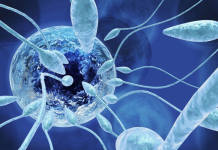Human skin performs many important functions in the body. It is involved in heat and gas exchange, the release of toxins, is a barrier to harmful environmental influences. Skin diseases are a serious problem, reflecting on the state of the body as a whole. One of the most aesthetically unpleasant diseases is perioral dermatitis. About his diagnosis and treatment is presented below.
Material Content:
What is perioral dermatitis?
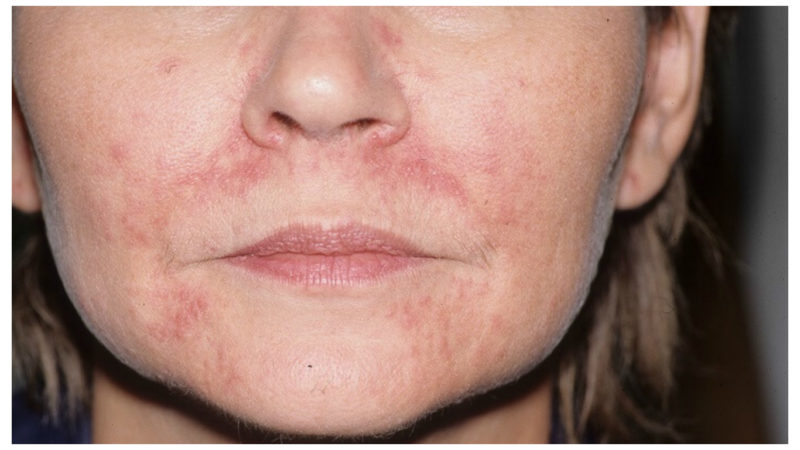
Perioral dermatitis is a pathological process that affects the skin in the mouth and chin. Therefore, sometimes in the medical literature this disease is called near-mouth dermatitis.
Skin lesions with this pathology are always associated with the appearance of rashes resembling rosacea (rosacea). Hence, another name - rosacea-like dermatitis. The disease is chronic. Once having acquired this form of dermatitis, a person should be prepared for possible relapses.
Perioral dermatitis is a relatively rare and predominantly “female” phenomenon. According to medical statistics, children and men are extremely infrequently affected by this disease. The main target of pathology is girls and women under the age of 40 years.
Causes of perioral dermatitis
Regarding the causes of this unpleasant problem, among doctors today there is no complete certainty. Moreover, it is unclear whether perioral dermatitis can be considered an independent nosological unit, since it is often closely associated with other diseases.
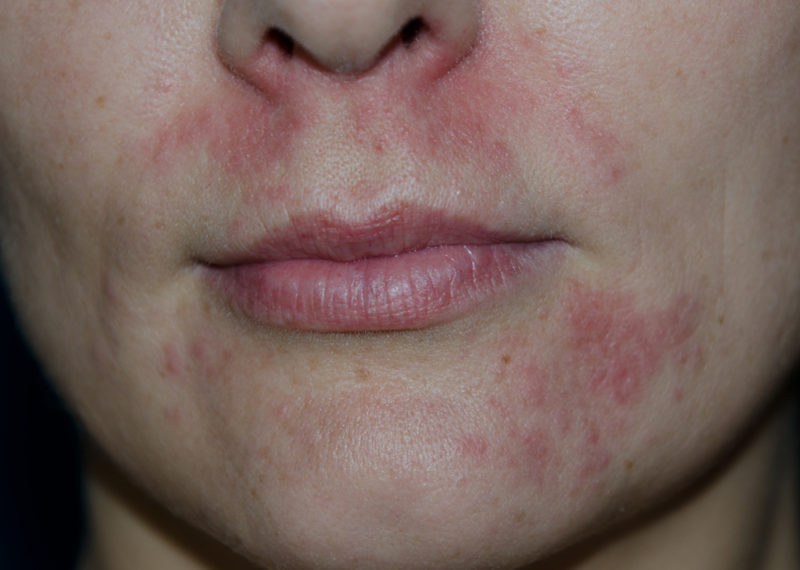
Sechenov Moscow Medical Academy researchers observed 132 patients of different sex and age. As a result, conclusions were made about pathologies concomitant with rosacea-like dermatitis:
- gynecological disorders - in 83.6% of patients of the female group;
- gastrointestinal diseases - in 67.4% of patients of the general group;
- chronic infections of the respiratory system and oral cavity - in 37.1% of patients in the general group;
- disorders of the nervous system in 32.6% of patients in the general group.
Sometimes perioral dermatitis overtakes people who have moved to live in another country, or during tourist trips. In this case, it is necessary to consider as a possible cause dysbiosis or intestinal infection, as well as parasitic infestations.
Provocateurs of the pathological process often become:
- skin fungi and bacteria;
- high humidity;
- intense ultraviolet radiation;
- chapping of the skin;
- decreased immunity;
- allergic diseases;
- hormonal fluctuations;
- the use of external corticosteroid ointments and creams;
- the use of fluoride-containing toothpaste;
- use of cosmetics.
Women should pay particular attention to the last point.
If there is a predisposition to perioral dermatitis, you should avoid cosmetics that contain petroleum jelly, paraffin, sodium lauryl sulfate and flavors with notes of cinnamon.
Symptoms
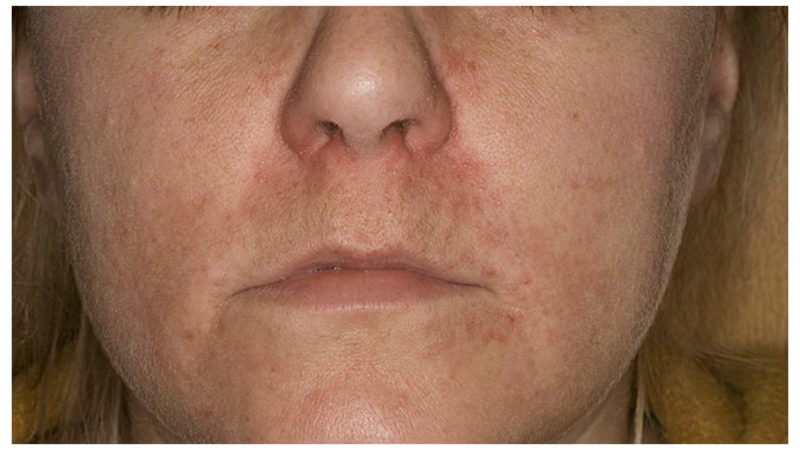
Perioral dermatitis on the face is manifested by the following set of symptoms:
- a feeling of tightness of the skin in the chin area and around the mouth;
- the appearance of itching and burning in the specified area;
- redness of the skin around the mouth and in the chin area;
- the appearance of papules - formations with a diameter of 2-3 mm, resembling small
- pimples, which over time fill with clear or purulent contents;
- peeling of the skin on the affected area.
At the very beginning of the disease, papules can be single, but gradually their number grows, rashes are grouped together.
If the patient does not receive treatment, the affected skin thickens and coarsens over time, becomes tuberous, becomes covered with age spots. In rare, especially advanced cases, a rash can be found on the upper and lower eyelids, and then the disease becomes potentially dangerous for vision.
How to diagnose?
The diagnosis in this case is the task of a dermatologist. Having found rashes resembling perioral dermatitis, you should visit him and pass a number of tests:
- skin scraping for bacterial culture;
- general blood analysis;
- blood chemistry;
- IgE blood test.
As a result of the examination, the doctor should exclude some diseases with similar manifestations: rosacea, seborrheic dermatitis, diffuse neurodermatitis and allergic dermatitis. Only after this is adequate treatment prescribed.
Treatment of perioral dermatitis
Unfortunately, perioral dermatitis is a pathology that is difficult to treat. The patient should be ready for long-term treatment. Sometimes the process takes several months.
First of all, the doctor will recommend the so-called “zero therapy”. Its essence lies in the complete abolition of all creams and ointments, hormonal drugs (corticosteroids), in the rejection of decorative cosmetics and fluoride-containing toothpaste. After that, depending on the condition of the patient, medication may be prescribed.
Ointments and medicines
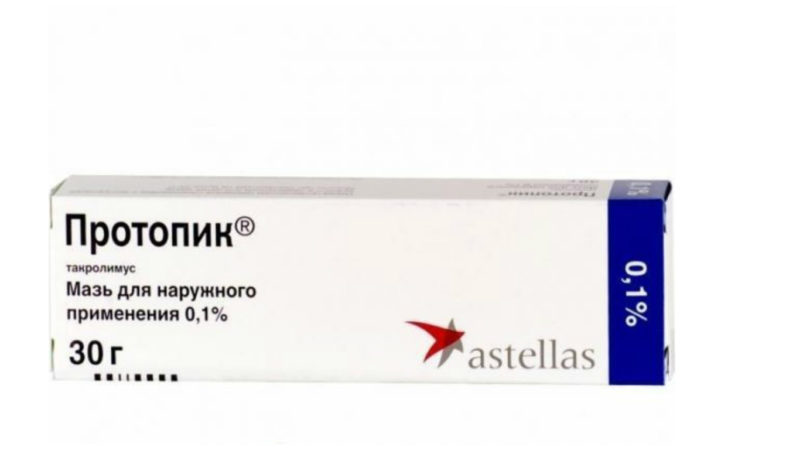
Drug therapy of perioral dermatitis includes the appointment of several groups of drugs:
| Anti-inflammatory and drying external agents | ||
| Drug name | Treatment regimen | Contraindications |
| Protopic, ointment 0.1% | Apply to the affected area 2 times a day. | • pregnancy and lactation; • age up to 16 years; • increased sensitivity; • severe violations of the epidermal barrier. |
| Elidel Cream | Apply a thin layer to the affected area 2 times a day. | • the attachment of a viral or bacterial infection in the lesion; • age up to 3 months; • increased sensitivity. |
| Antihistamines | ||
| Loratadine 10 mg tablets | 1 tablet per day 10 minutes before meals. The duration of the course depends on the condition, is controlled by a doctor. On average - 14-30 days. | • age up to 3 years; •lactation; • glucose-galactose malabsorption; • lactose intolerance; • lactase deficiency; • individual intolerance. |
| Suprastin tablets 25 mg | 1 tablet 3 times a day, without chewing. The duration of the course depends on the condition of the patient and is controlled by a doctor | • age up to 1 month; • pregnancy and lactation; • an attack of bronchial asthma. |
| Antibacterial and antifungal drugs | ||
| Metrogil (Metronidazole), gel | Apply a thin layer to the affected areas 2 times a day until the symptoms disappear. The standard course is 3-9 weeks. | • increased sensitivity. |
| Doxycycline, 100 mg tablets | 1 tablet 2 times a day until the symptoms disappear. Then a month - 1 tablet 1 time per day. Another month - 0.5 tablets once a day. | • age up to 12 years; • pregnancy and lactation; • increased sensitivity; • lactase deficiency; • lactose intolerance; • leukopenia; • impaired liver and kidney function. |
A specific treatment regimen for each patient is developed individually by the doctor. These drugs are not prescribed at the same time. The order of their use is regulated in accordance with the phase of treatment:
- For the period of “zero therapy”, in the acute phase of the disease, antihistamines are prescribed to reduce itching, burning, swelling and reduce the manifestations of the “withdrawal syndrome”. At the same time, an anti-inflammatory ointment is recommended for the treatment of perioral dermatitis. Physiotherapeutic procedures - cryomassage and acupuncture help to alleviate the condition.
- When the acute phase has passed, they begin antibiotic and antifungal therapy, combining external drugs and taking antibiotics inside.
After completion of the main treatment, a rehabilitation course is carried out. During this period, vitamin preparations and immunomodulators, means for restoring intestinal microflora are prescribed.
For the entire period of treatment, the patient is recommended to observe a number of rules. Damaged skin must be protected from ultraviolet rays, especially in summer. The effect of other aggressive weather factors, wind, frost, should be minimized. While the acute phase of the disease lasts, you will have to abandon decorative cosmetics, including foundation. In the future, any cosmetics should be selected, given the possibility of relapse of dermatitis.
ethnoscience

Compresses, wipes, lotions with decoctions and infusions of herbs, as well as home-made ointments are among the folk remedies for the treatment of perioral dermatitis.
| Means | Cooking | Mode of application |
|---|---|---|
| Infusion of birch buds | 1 tablespoon of raw materials is brewed with 1 cup of boiling water. It is infused in a warm place for an hour and filtered. | Used to wipe affected skin before applying therapeutic ointments. |
| Infusion of chamomile and calendula | 1 tablespoon of dried flowers of calendula and pharmacy chamomile is combined and brewed with 2 glasses of boiling water. It is infused under the lid for an hour and filtered. | A compress is made of pure gauze, folded in several layers, moistened abundantly in a chilled infusion and applied to the face for 15-20 minutes. |
| Decoction of the string | 4 tablespoons of raw materials are poured with 0.5 liters of boiling water. The composition is placed in a water bath and aged for an hour. After removing from the fire, the broth is wrapped, aged for another hour, filtered and cooled. | Cotton sponges are moistened in a cooled broth and applied to the affected areas. Lotions are kept on the face until heated, and then changed to fresh. |
| Propolis Ointment | For 1 part propolis, 4 parts of refined vegetable oil are taken.The raw materials are placed in refractory dishes and heated in the oven until propolis melts. Everything is well kneaded and cooled. | It is used to lubricate affected skin. |
| Aloe juice | The chopped fresh aloe stalk is washed with water and passed through a meat grinder. Porridge is placed in cheesecloth and squeezed. Liquid honey and medical alcohol are added to the resulting juice. Proportions - 1: 1: 1. | Used twice a day to wipe affected skin before applying therapeutic ointments. |
Judging by the reviews of patients, traditional medicine methods give a good result. They can be used as an alternative if there are contraindications to the use of drugs. However, with a severe course of the disease, folk remedies must be combined with drug therapy. In addition, it is important to monitor the reaction of the body - in some cases, an allergy to plant materials may develop.
It is interesting: cold allergy
Diet for perioral dermatitis
A diet for perioral dermatitis is a very important part of the treatment.
First of all, a number of potentially dangerous foods and dishes are excluded from the diet:
- sweets;
- citrus;
- coffee drinks
- caviar and sea fish;
- meat and eggs;
- soybeans;
- mushrooms;
- alcoholic drinks;
- fried, pickled, smoked food.
The menu of a patient with perioral dermatitis consists mainly of cereals, light soups, dairy products, steamed vegetables and salads of fresh vegetables. Dried bread, pasta, cheese, stewed fruits and jelly from natural berries, low-allergenic fruits - green apples, pears, bananas are allowed. You can eat poultry and river fish - boiled or in the form of steam cutlets.

It is very important to observe a drinking regimen. To get rid of toxins as soon as possible, you need to drink at least 2 liters of fluid per day. The calculation does not include soups or jelly. The consumed liquid should consist of drinking or mineral water, not strong green tea, decoctions of birch buds or rose hips. You can drink fruit or juice in a diluted form.
The development of the disease in childhood
Perioral dermatitis in children is a relatively rare occurrence.
The main causes of the development of pathology in childhood are as follows:
- reduced immunity due to frequent SARS;
- the use of sprays or inhalers with steroid drugs;
- waterlogging and chapping of the skin when sucking nipples;
- hypovitaminosis;
- dysbiosis.
In adolescents, the occurrence of perioral dermatitis may be associated with hormonal changes in the body or with the use of steroid drugs to treat acne.
The clinical manifestations of the disease in children do not have significant differences. The principles of treatment are the same as in the treatment of dermatitis in adults: the elimination of provoking factors, acute symptoms, antibacterial and rehabilitation therapy.
It should be noted that for young children it is quite difficult to tolerate the acute phase of the disease. Itching and burning on the skin bother babies and provoke them to rub and comb the affected area. Therefore, it is important to alleviate these symptoms as soon as possible. Cooling lotions and compresses with a decoction of a series become an excellent help in this.
From medications, the doctor can recommend the following drugs:
- "Protopic" ointment 0.03% - 2 times a day for 3 weeks. Then the frequency is reduced to 1 time per day - until recovery.
- "Loratadine", 10 mg tablets - 0.5 tablets 1 time per day (from 2 to 12 years), and 1 tablet 1 time per day (after 12 years).
- "Metrogil" gel - 2 times a day.
Treatment of children with antibiotics is carried out under the strict supervision of a doctor.
Periodic dermatitis during pregnancy
During pregnancy, near-mouth dermatitis occurs, as a rule, in the first trimester. It is during this period that the woman’s body experiences a serious load due to hormonal changes.Treatment in this case is a difficult task, since most of the usual medications are contraindicated in pregnant women.
During the first and second trimesters of the future mother will have to be limited to local treatment of affected areas of the skin. In this case, it is desirable to give preference to harmless external agents and physiotherapeutic procedures. Additionally, you need to follow a diet and protect your skin from the sun, wind and cosmetics. To relieve the manifestations of dermatitis, the doctor may prescribe an antihistamine.
Periodic dermatitis gives only cosmetic inconvenience to a pregnant woman. It does not affect the health of the unborn child.
If the expectant mother organizes proper skin care, eliminates provoking factors and pays attention to maintaining immunity, the symptoms of the disease will decline. After birth, the problem may completely disappear.
Near-mouth dermatitis is an unpleasant pathology, but with the right treatment tactics, the prognosis for recovery is favorable. And compliance with simple preventive measures can completely save the patient from relapse of this ailment.







